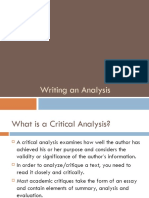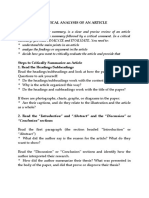Tips For Critical Analysis Essays 1
Uploaded by
nabeeha shahidTips For Critical Analysis Essays 1
Uploaded by
nabeeha shahidWhat is Analysis (sometimes called critical analysis)?
When you critically analyze a text you make evaluations (positive and negative) of the text. You
judge the text based on specific criteria like the relevance, coherence, logic, validity, findings, or
persuasiveness of the text. Often the assignment instructions will specify what you should focus
on.
Tips for Analyzing Scholarly Peer Reviewed Articles:
Tip #1: Make sure to include both summary and critical commentary.
Your critical analysis of a scholarly article should combine some summary with critical
commentary.
Ø You might summarize: the author’s thesis statement or overarching claim, minor claims,
and/or evidence.
Ø You should not only summarize: you should also evaluate the author’s claims. You
might critique: the author’s reasoning, evidence, and interpretation of facts, statistics
and data.
Tip #2: Evaluate the author’s argument by considering questions like the ones below. As you
read, pause and examine the effectiveness of the source.
• What are some strengths of the article?
• What are some problems/limitations/weaknesses with the author’s evidence?
• Are there any points the author makes that aren’t logical?
• Does the author overlook any important factors he/she should consider?
• What assumptions does the author make?
• How do the author’s claims connect to claims of other authors looking at the same
issue?
• How does the author’s writing style and word choice affect his/her argument?
• How does the author establish credibility?
• What is the author’s intended purpose?
Not all of these questions will be relevant. Choose a few to focus on.
Tip #3: Choose a few key points about the source to write in your analysis essay. Avoid listing
all of your observations about the text. Instead choose just a few critiques and weave them into
an argument about the source.
Tip #4: You will most likely need to read/examine the source you are analyzing more than
once. If you are reading a complex article, you should not expect to fully understand the article
the first time. As you read, you might want to annotate the text by highlighting key ideas. You
may also want to summarize the author’s main points. Re-read the text until you’re able to:
• Understand the author’s thesis/claim
• Recognize the author’s main points that support the thesis
• Understand concepts that are essential to the author’s argument (terms/concepts from
a specific field, e.g. psychology terms)
• Identify weaknesses in the author’s argument
Created by AUSB Writing Center (Last updated 12/14/16)
A Potential Outline for a Critical Analysis Essay
1. Provide any essential background that is relevant to your thesis
statement. Keep your background section narrow: avoid writing
Introduction about the whole history of your topic.
2. State the author’s thesis
3. Summarize the author’s main reasons that support his/her claim
4. Include your own thesis (your claim about the work you are
analyzing)
Example thesis about Michael Moore’s documentary Sicko:
Moore (2007) relied too heavily on exaggeration and cherry-picked facts
which damaged the effectiveness of his argument.
In your analysis paragraphs you will critically evaluate the effectiveness
of the source. You can evaluate:
See Tip #2
o Strengths or weaknesses of the author’s claims
on reverse
o Limitations of the author’s evidence
o Perspectives, biases, values, or assumptions that appear to play
a role in the author’s argument
o The author’s organization, writing style, or intended purpose
Each paragraph should include:
Analysis Paragraphs 1. A topic sentence that evaluates one key aspect of the work and
You could have any number of connects back to your thesis statement
analysis paragraphs. 2. Evidence: Specific details about the source (quotes, paraphrases,
summaries of key ideas). Include sufficient references to the
Each analysis paragraph should
present one key idea. source material.
3. Analysis of the evidence: Don’t assume the evidence speaks for
itself. Include critical statements that tell the reader the
importance of the evidence (statements that interpret/analyze See our
the material for your reader). “Quote
Sandwich”
Resource
Don’t just restate what you wrote before.
1. Comment on the balance between the article’s strengths and
weaknesses
Conclusion 2. Include some final comment on the value of the source
3. Look to the bigger picture in some way (comment on the future
of the issue/topic or implications)
Examples of the bigger picture for Moore’s documentary Sicko:
• How other sources/news sources have addressed the same issue
more ethically.
• Why accurate investigative journalism is important for changing
public sentiment about health care reform.
Created by AUSB Writing Center (Last updated 12/14/16)
You might also like
- The Absolutely True Diary of A Part-Time Indian55% (170)The Absolutely True Diary of A Part-Time Indian35 pages
- Marcus T. Bottomley - Real Magick For Real Problems93% (92)Marcus T. Bottomley - Real Magick For Real Problems64 pages
- The Best Poems Ever - The Greatest Poetry of All Time100% (3)The Best Poems Ever - The Greatest Poetry of All Time23 pages
- Guide To The Srewtape Letters by C.S. Lewis100% (5)Guide To The Srewtape Letters by C.S. Lewis13 pages
- How To Write Analysis Paper?: Agenda HousekeepingNo ratings yetHow To Write Analysis Paper?: Agenda Housekeeping13 pages
- Writing Assignments (x2) : Critical AnalysisNo ratings yetWriting Assignments (x2) : Critical Analysis4 pages
- Critical Analysis and Writing The CritiqueNo ratings yetCritical Analysis and Writing The Critique7 pages
- Critical Analysis Integrating Theory and Practice 2No ratings yetCritical Analysis Integrating Theory and Practice 24 pages
- How To Write A Critical Analysis - 17 Steps - WikiHowNo ratings yetHow To Write A Critical Analysis - 17 Steps - WikiHow6 pages
- نسخة Week 10 PPT DENG400 Critical Thinking Writing Module 09No ratings yetنسخة Week 10 PPT DENG400 Critical Thinking Writing Module 0919 pages
- Writing Center: How To Write An AnalysisNo ratings yetWriting Center: How To Write An Analysis1 page
- Critical Analysis of A Journal Article: Skills For LearningNo ratings yetCritical Analysis of A Journal Article: Skills For Learning8 pages
- Getting Started: Assessing Sources/Creating A Matrix/Writing A Literature ReviewNo ratings yetGetting Started: Assessing Sources/Creating A Matrix/Writing A Literature Review3 pages
- Presentation - Academic Writing Skills 2023No ratings yetPresentation - Academic Writing Skills 202330 pages
- Developing A Critical Analysis of A TextNo ratings yetDeveloping A Critical Analysis of A Text6 pages
- Learning How To Analyze An Article Special EditionNo ratings yetLearning How To Analyze An Article Special Edition3 pages
- Analysis Essay Guidelines Gender in MediaNo ratings yetAnalysis Essay Guidelines Gender in Media3 pages
- Analysis Evaluation 2018 Final Color CodedNo ratings yetAnalysis Evaluation 2018 Final Color Coded2 pages
- Understanding Essay Writing: A Guide To Writing Essays By Someone Who Grades ThemFrom EverandUnderstanding Essay Writing: A Guide To Writing Essays By Someone Who Grades Them4/5 (4)
- The Student’s Guide to Writing: Essential Outlines and StrategiesFrom EverandThe Student’s Guide to Writing: Essential Outlines and StrategiesNo ratings yet
- How to Write a Dissertation: An Instructional Manual for Dissertation Writers.From EverandHow to Write a Dissertation: An Instructional Manual for Dissertation Writers.No ratings yet
- New Syllabus Mathematics Workbook 1 (CHP 14)No ratings yetNew Syllabus Mathematics Workbook 1 (CHP 14)10 pages
- FROZEN Music From The Motion Picture Soundtrack100% (2)FROZEN Music From The Motion Picture Soundtrack72 pages
- Santiago, National High School Senior High School Department50% (2)Santiago, National High School Senior High School Department4 pages
- Name: - Control No.: - Address: - Parent's Signature: - Contact No.100% (1)Name: - Control No.: - Address: - Parent's Signature: - Contact No.50 pages
- English Quarter 3 - Module 2: Use Variety of Informative, Persuasive, and Argumentative Writing Techniques100% (2)English Quarter 3 - Module 2: Use Variety of Informative, Persuasive, and Argumentative Writing Techniques7 pages























































































































